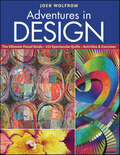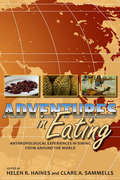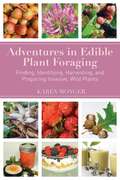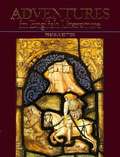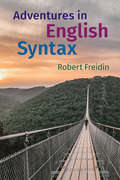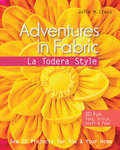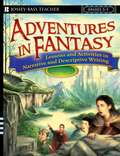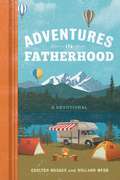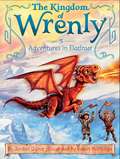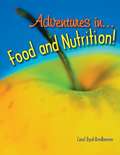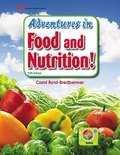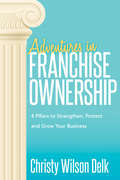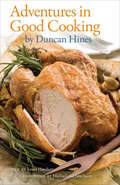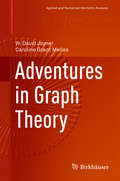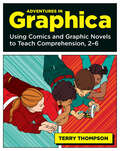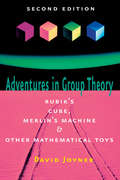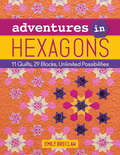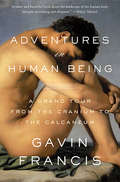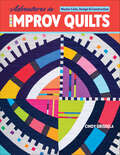- Table View
- List View
Adventures in Darkness: Memoirs of an Eleven-Year-Old Blind Boy
by Tom SullivanIn Adventures in Darkness, Tom Sullivan takes readers through the adventures of his monumental eleventh year. Blind since birth, Tom lived in a challenging world of isolation and special treatment. But he was driven to break out and live as sighted people do. This book is a hair-raising, heart-warming experience that culminates in Tom's reliance upon God to realize his dreams of a "normal" life.
Adventures in Design: The Ultimate Visual Guide, 153 Spectacular Quilts, Activities & Exercises
by Joen WolfromBring more beauty and balance to your quilt designs • Everything you need to know about the essentials of good design from an internationally reknowned expert • Learn about the key elements of design and how to apply strategies for success • Practice what you've learned with exercises at the end of each chapter • An inspiring gallery illustrates design concepts by many prominent quilters and artists - including Alex Anderson, Paula Nadelstern, and Ricky Tims - with over 150 images showcasing all styles of quilts and fabric art, from traditional to modern This is the design textbook for quilters. Joen presents the eight elements of design: line, direction, shape, color, value, texture, proportion, and scale. You'll learn how to work with these elements using many guiding design principles, such as unity and balance. Whether you consider yourself to be a quilter, an artist, or a crafter, you can improve your design skills by exploring Joen's fresh, innovative approach.
Adventures in Eating: Anthropological Experiences in Dining from Around the World
by Clare A. Sammells Helen R. HainesAnthropologists training to do fieldwork in far-off, unfamiliar places prepare for significant challenges with regard to language, customs, and other cultural differences. However, like other travelers to unknown places, they are often unprepared to deal with the most basic and necessary requirement: food. Although there are many books on the anthropology of food, Adventures in Eating is the first intended to prepare students for the uncomfortable dining situations they may encounter over the course of their careers. Whether sago grubs, jungle rats, termites, or the pungent durian fruit are on the table, participating in the act of sharing food can establish relationships vital to anthropologists' research practices and knowledge of their host cultures. Using their own experiences with unfamiliar-and sometimes unappealing-food practices and customs, the contributors explore such eating moments and how these moments can produce new understandings of culture and the meaning of food beyond the immediate experience of eating it. They also address how personal eating experiences and culinary dilemmas can shape the data and methodologies of the discipline. The main readership of Adventures in Eating will be students in anthropology and other scholars, but the explosion of food media gives the book additional appeal for fans of No Reservations and Bizarre Foods on the Travel Channel.
Adventures in Edible Plant Foraging: Finding, Identifying, Harvesting, and Preparing Native and Invasive Wild Plants
by Karen MongerPurchasing vegetables and leafy greens can become rather pricy. Moreover store-bought greens often contain unhealthy pesticides and chemicals that can be harmful to your health. Foraging for wild plants is a cost effective and healthy alternative. Harvested wild plants are cheaper, and much healthier with a significantly higher nutritional value than what you typically purchase in grocery stores contain. On top of that, harvesting your own plants will force you to get out, exercise, and explore the great outdoors, which is an excellent way to stay fit and spend time with your family. Written with novice foragers in mind, Adventures in Edible Plant Foraging, serves as a simplified guide to edible plants that can be found throughout North America, and includes a glossary of botanical terms. This all encompassing guide will teach you how to prepare for your first foray into foraging--what to bring and what to watch out for--and show you how to identify various edible wild plants native to your own backyard, the forest, fields and the sandy shores along lakes and beaches. With over 90 full color photographs and 20 recipes for soups, salads, muffins, desserts, and more, this book is a must have for anyone looking to save money and begin their first expedition into foraging.
Adventures in English Literature
by William Reach; John Richetti; Bruce RobbinsThis is a book that was handed down to me from my grandparents after they passed away. It's really outdated and doesn't serve much of a useful purpose aside from having another vintage 'textbook' hanging around on my bookshelves that holds a bit of a memory.
Adventures in English Literature (Heritage Edition)
by Leopold Damrosch Leonard F. Dean William Reach Getald LevinThis book is an effective compilation of literary works by various authors, ranging through the Anglo-Saxon period to Elizabethan to Victorian age, Shakespeare to John Milton to Bernard Shaw.
Adventures in English Syntax
by Robert FreidinFor anyone who wants to become a more effective writer, a more perceptive reader, and a more precise thinker, an understanding of English sentence structure is indispensable. This book shows you how to begin. Using clear and engaging examples from English, it introduces the basic concepts of syntactic structure to readers with no background in linguistics. Starting with simple, familiar phrases, and progressing to more complex sentences, it builds on what we already intuitively know, to provide a step-by-step account of why we understand these examples as we do. It then shows how that understanding can be applied to writing, helping us to avoid some of the common hallmarks of 'bad writing', such as ambiguity, redundancy, and vagueness. A unique and valuable resource, this book will enrich your understanding of English in ways that will make you a more effective user of the language.
Adventures in Extreme Golf: Incredible Tales on the Links from Scotland to Antarctica
by Duncan LennardFor many golfers, the innocent thrill of striking a drive clearly, avoiding a deep bunker, or holing out an unlikely putt is all they need to make a round (or a whole year) of golf memorable. But there's an obsessed subculture of modern players in search of something more. They've rediscovered the magic of the game in Adventures in Extreme Golf, and their adventures are about to inspire golfers everywhere.Follow golfers like Andre Tolme and Torsten Schilling who go to Mongolia to play in a par 11,880 course, to 12,000 feet at Snowmass in Aspen, to the "naked open" in New Zealand, and to the freezing temperatures of Antarctica.Duncan Lennard describes a world at the very edge of sport, where the courses may be only ten holes long, but the average length of each hole is 638 yards. Learn that your resilience, and not just a pretty swing, determines your success.Adventures in Extreme Golf will take you all over the world and show you that a par four is nothing compared to these holes. See courses you've only seen in your dreams (or rather, your nightmares) and follow Duncan Lennard as he takes you on a trip to see why these courses and holes are considered "extreme."
Adventures in Fabric: La Todera Style
by Julie M. CreusLearn creative new techniques for 3-D fabric creations with this guide featuring 20 fun and colorful projects from the designer behind La Todera.This festive collection from designer Julie Creus brings together bright fabrics, ingenious construction methods, and a large dash of whimsy to make 3-D effects like you've never seen before in fabric. Create usable art with new techniques for fabric folding, fusing, weaving, and thread wrapping. Julie Creus shares step-by-step instructions for 20 truly unique projects—including brooches, pillows, table decor, sewing accessories, holiday decorations, children's softies, and more. These scrap-friendly projects are usable, beautiful, and fun to make. Julie's inventive methods make the sewing easy, whether you are a beginning or expert sewist.
Adventures in Fairyland
by Enid BlytonOne in a series of six classic Enid Blyton tales of goblins, imps, pixies, wizards and magic. This volume contains nine enchanting tales from the land of the weird and wonderful. This is a collection of wicked wizards, evil enchanters, clever children and lots more.
Adventures in Fantasy
by John GustAdventures in Fantasy offers an exciting approach to teaching narrative and descriptive writing that stimulates a student's creativity and imagination. Filled with mini-lessons, reading projects, and hands-on writing activities, the book shows teachers step-by-step how to introduce students to the "magic" of creating a complete story in the fantasy/adventure genre. Before fleshing out their stories, however, students are asked to construct actual maps of their 'fantasyland' - and then to write a travelogue describing the setting in vivid detail. This initial fantasizing encourages students to be wildly inventive in creating the drama, ogres, villains, heroes and heroines featured in their story, and on the way they learn about the mythic journey.
Adventures in Fatherhood: A Devotional
by Holland Webb Carlton HughesAdventure along with two dads in a devotional journey full of wisdom and warning.Being a great father is not for the weak of heart! It's an adventure every step of the way. Whether you're fixing boo-boos and changing diapers, or coaching soccer and carpooling teenagers, you'll find spiritual insight and practical advice in this devotional by Carlton Hughes and Holland Webb. The authors blend personal experiences with humor and spiritual application to encourage you, dad, to do your best for God and for your family. Ellie Claire's devotionals offer short inspirational readings, paired with inspiring quotes and Scripture verses to encourage your heart. FEATURES:Devotions written specifically for dadsRugged, durable packagePerfect size for coat pocket or briefcasePresentation page for personalizationRibbon markerA great gift for Father's Day, dad's birthday, or Christmas
Adventures in Flatfrost
by Jordan Quinn Robert McphillipsPrince Lucas and Clara venture to the land of the giants and train Ruskin to control his fire in this fifth chapter book in the fantastical Kingdom of Wrenly series.After a game of hide-and-seek, Prince Lucas and Ruskin are in trouble again. They have melted all the ice in the castle, and the king is not pleased. He sends Lucas and Ruskin to Flatfrost to fetch more ice from the giants who live there. High in the snowy mountains, some new larger-than-life friends lend a helping hand as Lucas, Clara, and Ruskin learn to respect the hard work of others. With easy-to-read language and illustrations on almost every page, The Kingdom of Wrenly chapter books are perfect for beginning readers.
Adventures in Food and Nutrition!
by Carol Byrd-BredbennerAdventures in Food and Nutrition! is designed to help you explore the exciting world of food and nutrition. You will explore beyond familiar foods and preparation methods. A multicultural, multiethnic emphasis will encourage you to try new foods.
Adventures in Food and Nutrition!
by Carol Byrd-BredbennerIntroduce your students to food and nutrition with Adventures in Food and Nutrition! Packed with student appeal, this full-color text generates student interest with action photos, interesting activities, and real-world experiments. The text encourages students to develop scientific and inquiry skills as they learn about nutrition, food management, and preparation. The text is written at a lower level for younger students or beginning level classes. -- Multicultural focus, reflecting foods from a cross section of diverse backgrounds. -- Math and science applications and activities are provided throughout the text and in special-interest features. -- Involves students in the science and creativity of preparing meals and snacks. -- Chapters include Objectives, New Terms, Review Questions, Application Questions, Activities, and a Summary.
Adventures in Food and Nutrition! (Fifth Edition)
by Carol Byrd-BredbennerAdventures in Food and Nutrition! is a great resource for helping your students begin an exciting study of nutrition, food management, and preparation. The appealing, youthful writing style and colorful photographs draw students' attention, and the lower reading level makes this text anexcellent choice for younger students and introductory classes. Interesting features appear throughout the text to encourage students to use math and science concepts as they consider the link between nutrition and health. These features also introduce students to food technology innovations,increase their appreciation of diverse cultures, and motivate them to explore careers. In addition, problem-solving scenarios empower students to develop critical-thinking skills as they apply learning.
Adventures in Franchise Ownership: 4 Pillars to Strengthen, Protect and Grow Your Business
by Christy Wilson DelkWritten in the style of a business &‘tell-all&’, Adventures in Franchise Ownership lays out what successful franchisees do that you won&’t find in most owner&’s manuals and includes franchisee Christy Wilson Delk&’s good, bad, and really tough days before her successful exit 15 years later. Franchisees, like most small business owners, experience times of extreme frustration, lapses in motivation, and often exit before reaching their potential and their goals. Based on Christy&’s real-life franchise ownership adventures, this guide explains how her 4 Pillar to Pillars Approach helps all franchise owners get to the top tier of their franchise system and includes advice from 16 top performers representing over a dozen market segments. With humor, candor, and relatability, Christy fills in the gaps of the franchise Owner&’s Manual by providing a constructive framework for finding professional satisfaction and attaining the financial success franchise owners everywhere want and deserve.
Adventures in Good Cooking
by Duncan HinesAn all-American classic: &“For the first time in decades, we can revisit the best recipes from some of the best restaurants of the &’40s and &’50s.&” —St. Louis Post-Dispatch Adventures in Good Cooking was a culinary landmark. Duncan Hines had left his native Kentucky and crisscrossed the country as a traveling salesman, becoming a national tastemaker in the process by reporting on the many restaurants he visited. Eventually, his recommendations became so popular that he published his first cookbook at age fifty-nine. This bestselling collection featured recipes contributed by select restaurants from coast to coast as well as crowd-pleasing family favorites, and it helped to raise the standard for home cooking in America. Filled with succulent treats, from the Waldorf-Astoria&’s Chicken Fricassee to the Oeufs a la Russe served at Antoine&’s Restaurant in New Orleans to Mrs. Hines&’s own Christmas Nut Cake, this book includes classic recipes from top chefs and home cooks alike. Includes a new introduction by Hines biographer Louis Hatchett and a valuable guide to the art of carving
Adventures in Graph Theory (Applied and Numerical Harmonic Analysis)
by W. David Joyner Caroline Grant MellesThis textbook acts as a pathway to higher mathematics by seeking and illuminating the connections between graph theory and diverse fields of mathematics, such as calculus on manifolds, group theory, algebraic curves, Fourier analysis, cryptography and other areas of combinatorics. An overview of graph theory definitions and polynomial invariants for graphs prepares the reader for the subsequent dive into the applications of graph theory. To pique the reader's interest in areas of possible exploration, recent results in mathematics appear throughout the book, accompanied with examples of related graphs, how they arise, and what their valuable uses are. The consequences of graph theory covered by the authors are complicated and far-reaching, so topics are always exhibited in a user-friendly manner with copious graphs, exercises, and Sage code for the computation of equations. Samples of the book's source code can be found at github. com/springer-math/adventures-in-graph-theory. The text is geared towards advanced undergraduate and graduate students and is particularly useful for those trying to decide what type of problem to tackle for their dissertation. This book can also serve as a reference for anyone interested in exploring how they can apply graph theory to other parts of mathematics.
Adventures in Graphica: Using Comics and Graphic Novels to Teach Comprehension, 2-6
by Terry ThompsonGraphica is a medium of literature that integrates pictures and words and arranges them to tell a story or convey information, usually presented in a comic strip, periodical, or book form AKA comics. It's no surprise comics have long been popular with kids and adults; some of our greatest heroes were introduced to us in comic form. Drawing on his own success using graphica with elementary students, literacy coach Terry Thompson introduces reading teachers to this popular medium in Adventures in Graphica: Using Comics and Graphic Novels to Teach Comprehension, Grades 2-6. In his book, Thompson explains how graphica can be an engaging and motivating tool for reluctant readers who often shun traditional texts. He suggests sources of appropriate graphica for the classroom and demonstrates how to fit this medium into the literacy framework and correlates with best practices in comprehension, vocabulary, and fluency instruction.Adventures in Graphica contains numerous, easy-to-replicate, instructional strategies, including examples of how graphic texts can be used to create a bridge and students transfer abstract comprehension strategies learned through comics and graphic novels to traditional texts. It is an excellent roadmap for teachers looking to add graphica to their classrooms.
Adventures in Group Theory: Rubik's Cube, Merlin's Machine, and Other Mathematical Toys
by David JoynerThis updated and revised edition of David Joyner’s entertaining "hands-on" tour of group theory and abstract algebra brings life, levity, and practicality to the topics through mathematical toys.Joyner uses permutation puzzles such as the Rubik’s Cube and its variants, the 15 puzzle, the Rainbow Masterball, Merlin’s Machine, the Pyraminx, and the Skewb to explain the basics of introductory algebra and group theory. Subjects covered include the Cayley graphs, symmetries, isomorphisms, wreath products, free groups, and finite fields of group theory, as well as algebraic matrices, combinatorics, and permutations.Featuring strategies for solving the puzzles and computations illustrated using the SAGE open-source computer algebra system, the second edition of Adventures in Group Theory is perfect for mathematics enthusiasts and for use as a supplementary textbook.
Adventures in Hexagons: 11 Quilts, 29 Blocks, Unlimited Possibilities
by Emily Breclaw“Expert step-by-step instructions to help you create a stunning quilt that will make your friends ask, ‘How did you do that?’” —Quilter’s ConnectionMove beyond one-patch hexagon layouts with eleven show-stopping hexie projects to stitch by hand or machine. Sew blocks in a variety of sizes and pieced combinations for stunning visual effects! You’ll master the Y-seam with a variety of techniques to cut and piece hexagons. Mix it up with the author’s design primer, which gives you the tools to draft your own unique hexie quilt layout.“Breclaw’s thoughtful instruction and logical processes for assembly will guide both beginners and experienced quilters.” —Library Journal
Adventures in Human Being: A Grand Tour from the Cranium to the Calcaneum
by Gavin FrancisWe assume we know our bodies intimately, but for many of us they remain uncharted territory, an enigma of bone and muscle, neurons and synapses. How many of us understand the way seizures affect the brain, how the heart is connected to well-being, or the why the foot holds the key to our humanity? In Adventures in Human Being, award-winning author Gavin Francis leads readers on a journey into the hidden pathways of the human body, offering a guide to its inner workings and a celebration of its marvels.Drawing on his experiences as a surgeon, ER specialist, and family physician, Francis blends stories from the clinic with episodes from medical history, philosophy, and literature to describe the body in sickness and in health, in life and in death. When assessing a young woman with paralysis of the face, Francis reflects on the age-old difficulty artists have had in capturing human expression. A veteran of the war in Iraq suffers a shoulder injury that Homer first described three millennia ago in the Iliad. And when a gardener pricks her finger on a dirty rose thorn, her case of bacterial blood poisoning brings to mind the comatose sleeping beauties in the fairy tales we learn as children.At its heart, Adventures in Human Being is a meditation on what it means to be human. Poetic, eloquent, and profoundly perceptive, this book will transform the way you view your body.
Adventures in Improv Quilts: Master Color, Design & Construction
by Cindy GrisdelaTake on color and creativity—discover three different ways to improv quilt, creating one-of-a-kind works of art. Find inspiration in Improv and start your journey with bold colors and unique designs! Improv expert Cindy Grisdela shares the design principles and construction strategies for successful quilts every time. Explore three different ways to create improvisationally, from the easiest―using one block in different colors and orientations―to combining block units using various techniques―to aspirational, free cutting the entire quilt and designing it on the wall before sewing. Finished creations result in one-of-a-kind artwork! · Master three different improvisational styles to create original works of art · Design and construction process made easy with expert strategies Guided exercises will have you creating stunning Improv quilts in no time

